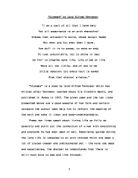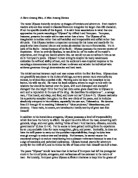It is significant in this text that change is inevitable, and change inevitably leads to death. This is represented through water lilies blooming which symbolizes death and also through the mirror cracking, symbolizing bad luck and contempt for her leaving the dwelling. Her longing and sighing whilst being insanely attached to her mirror also indicates change was soon to come, making death inevitable.
Even though she only lived for a short moment in the real world, her whole existence locked in a tower weaving all day wouldn’t have amounted to what she experienced in reality. Had she of stayed in her tower, no one would have understood or even known of her existence, further proving that without change one cannot live and without accepting change as a necessary agent to developing and transformation, happiness and fulfillment cannot be achieved.
We can see the very similar message in Tennyson’s Ulysses. By the use of vast emotive language, it is conveyed that Ulysses cannot stand the act of standing still and longs for the adventure and danger he lived by before returning home to his aged wife, son and island kingdom.
In the first 4 lines of the poem we receive a sense of Ulysses’ restlessness and utter boredom, sick of remaining stagnated on a small island. As the poem continues Ulysses revisits the days he fought in troy and sailed the world. The repetition of the word ‘greatly’ “Greatly, have suffered greatly..” illustrates his need or the extreme. For change.
“To rust unburnish’d not to shine in use as to breathe were life” indicates that we aren’t living by simply breathing. It suggests that we do not merely exist by the act of breathing but we need to contain a sense of danger, new things and importantly; change.
There are constant references to death in the poem “Tis not too late to seek a newer world.. To sail beyond the sunset, and the baths of all the western stars”. This suggests that the afterlife can exist as the ultimate journey, the most adventurous and exciting form of transition; something Ulysses anticipates. It is indicated in the poem that Ulysses leaves for his last journey, the journey of death.
From both of Tennyson’s poem we can see that without change we are stuck at a stand still, making the need for this change inevitable. It can be said that death accompanies change, but this is the risk both Ulysses and The Lady of Shallot took by partaking in change. They both maximized their lives, change being the agent – knowing their fate was in their own hands was the greatest security they had both ever encountered.
‘The Door’ by Miroslav Holub is a proto-political poem written as a part of the effort of Czech artists and intellectuals attempting to liberate the communist system through cultural acts and writings. The poem urges us to ‘Open the door’ and take a fresh look on life instead of settling into predictable patters or searching for synthetic happiness outside of ourselves through what others can provide.
The use of the imperative creates an urgent and important tone which further demands the reader to take a risk, take action or change their normal and repetitive behavior. The door is presented as a symbol in the poem. It is something we can recognize and relate to as a frontier or a barrier; one we can’t see through or predict what lay on the other side. It can also exist as a metaphor for our own personal barriers, or our closed mindedness.
Holub makes it apparent that all free humans have the ability to choose to open the door, and it is by this choice and will that we may come across something different, not by accident, but because of the choice we made. He also reminds us that there are no guarantees of what is on the other side, and this is the risk we take when choosing to change. Holub displays that change can come bearing gifts whether it is a garden, a magic city, a clearing fog or at least a draught.
He illustrates that change isn’t easy to the unwilling because you have to want to know what is beyond the door and until you decide to know, the future will remain unknown and we remain locked inside in utter stagnation. It is from these three poems that we can gather; change is an important and unavoidable process that we all have to endure in order to maximize our existence as human beings.
Lily Quinn, the protagonist IS ‘The Girl in Times Square’ – a novel by Paulina Simmons. An introverted artist, completely unaware of her surroundings, dislikes change of any sort. Although, she soon comes to realize throughout the course of huge events; winning the lottery, her best friend going missing, cancer and a new love that change is necessary in order to survive. Lily later acknowledges and understands that change must occur for the truth to be revealed.
When Lily is diagnosed with cancer, she has to change her habits and cash her lottery ticket, death being the result of remaining unchanged. She concludes that the future is not a result of choices among alternate paths offered by the present, but a place that we create using our minds and will, then in activity. The future is a place we are creating not going to. The path is to be made not found and through change she can achieve the most unique and fulfilling destinations.
It is from the didactive nature of all of these texts we can conclude that change is inevitable. Change can be positive or negative. With change comes responsibility, but the price is always worth what we got for it. The emotive, descriptive language and imagery used in Tennyson’s poems, symbolism and simplicity of ‘The Door’ and the mystery of ‘The Girl in Times Square’ all profoundly affect the way I have viewed change as a necessary element of living, making it so simple to say that Change by itself is the most powerful agent to growth and transformation.







